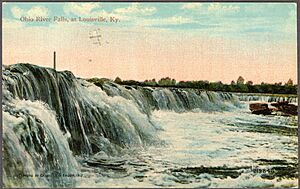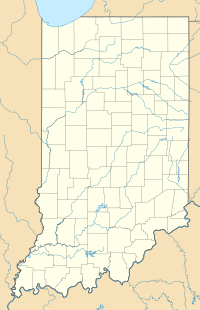Falls of the Ohio State Park facts for kids
Quick facts for kids Falls of the Ohio State Park |
|
|---|---|
|
IUCN Category III (Natural Monument)
|
|
| Location | Clark County, Indiana, US |
| Nearest city | Clarksville, Indiana |
| Area | 165 acres (67 ha) |
| Established | 1990 |
| Visitors | 158,680 (in 2018–2019<) |
| Governing body | Indiana Department of Natural Resources |
Welcome to Falls of the Ohio State Park! This amazing park is in Indiana, right on the banks of the Ohio River. It sits across from Louisville, Kentucky, in a town called Clarksville, Indiana. The park is famous for its incredible fossil beds. These beds show us what life was like millions of years ago!
About 160,000 people visit the park every year. It's also a historic spot. The famous explorers Lewis and Clark met here before their big journey. They gathered at George Rogers Clark's cabin right at the Falls.
Contents
Discover Ancient Life at the Falls
The main attraction at Falls of the Ohio State Park is its huge fossil beds. These beds are made of Jeffersonville Limestone. They date back to the Devonian period, about 390 million years ago! Back then, this area was covered by a warm, shallow sea.
You can see the remains of ancient sea creatures here. There are corals, sponges, and other animals that lived long, long ago. It's like a giant outdoor history book!

Explore the Interpretive Center
The park has a special building called the Interpretive Center. It's like a museum where you can learn even more! The center opened in 1992. It cost about $4.9 million to build.
Inside, you'll find exhibits about the park's natural history. You can learn all about the fossils and the ancient sea. There are also displays about the human history of the area. This includes stories from before settlers arrived. It also covers the history of Louisville and southern Indiana up to the 1900s.
Visiting the Center
Unlike other state parks in Indiana, there's a small fee to enter the Interpretive Center. Even if you have an annual park pass, you'll still pay a small amount. This helps the town of Clarksville, which helped build the center.
Walk the Woodland Loop Trail
The park also has a fun trail called the Woodland Loop Trail. Along this trail, you'll find ten cool stainless steel markers. These markers help you identify the different plants growing in the park. An Eagle Scout helped create this project!
Images for kids
See also
- The Filson Historical Society
- List of attractions and events in the Louisville metropolitan area
- List of fossil sites
- Old Clarksville Site
- Falls of the Ohio National Wildlife Conservation Area: More information about the geology of the Falls









